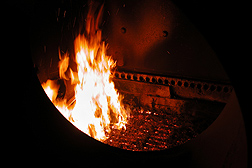According to a recent study by the U.S. Department of Agriculture (USDA), using switchgrass pellets could be a cheaper source of energy, instead of fuel oil to heat homes and businesses in the Northeast. Agricultural Research Service (ARS) researcher Paul Adler led efforts on a lifecycle analysis that compared costs of energy generation from coal, natural gas, fuel oil, and switchgrass in the form of energy-dense cubes, briquettes, and pellets.
 The researchers calculated the economic outlays associated with switchgrass production throughout the supply chain, as well as greenhouse gas emissions generated by switchgrass production, densification, and conversion to heat and power. This included the first lifecycle inventory of switchgrass seed production and greenhouse gas emissions associated with seed production.
The researchers calculated the economic outlays associated with switchgrass production throughout the supply chain, as well as greenhouse gas emissions generated by switchgrass production, densification, and conversion to heat and power. This included the first lifecycle inventory of switchgrass seed production and greenhouse gas emissions associated with seed production.
The analysis indicated that 192 pounds of “carbon dioxide equivalent,” or CO2e, was emitted for every ton of switchgrass dry matter that was sown, harvested, and delivered to densification plants for processing into pellets. CO2e is a measurement used to compare the emissions from various greenhouse gases based upon their global warming potential.
The researchers calculated that using switchgrass pellets instead of petroleum fuel oil to generate one gigajoule of heat in residences would reduce greenhouse gas emissions by 146 pounds of CO2e. Totaling all costs associated with installing an appropriate residential heating system and fuel consumption, the team concluded that each gigajoule of heat produced using switchgrass pellets would cost $21.36. Using fuel oil to produce the same amount of heat would cost $28.22.
Adler is now working with Plainview Growers to determine how the carbon footprint differs between heating greenhouses with biomass and heating them with fuel oil. The results of the research were published in the journal, Environmental Science & Technology.

